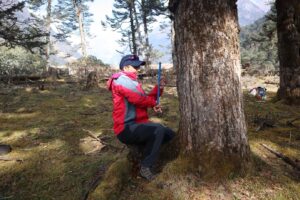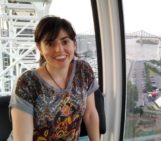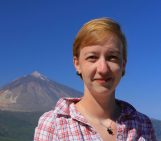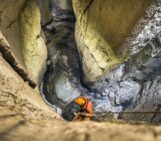
Hi Naz. Thanks for joining us for this edition of GeoTalk! How did you get into studying tree rings?
Hello, thank you for inviting me! Well there is an interesting story behind this so let me share it with you. I was always fascinated by our natural environment, particularly mountains, glaciers, and rivers. That motivated me to study Geography for my Bachelor and Master Degrees. For my MSc dissertation at the School of Geography, University of Leeds, UK, I did research on glacial lake outburst floods (GLOFs) in the Himalayas and conducted fieldwork in the Eastern part of the Himalayas. While doing my dissertation, I realised how important and timely it was to research devastating natural hazards, such as GLOFs or any other flood events, in the Himalayan context – particularly in this climate crisis era. I started investigating further to find long-term records (>100 years) of flood events in the Himalayas, but unfortunately didn’t find any. That kept me busy doing my literature review: identifying a suitable method for reconstructing paleoflood events.
Later, I found this fascinating field called “Dendrochronology” which accurately dates not just flood events, but many other hydroclimatic events in the past.
I got very interested in this domain. I decided to use this method in my PhD and developed a research proposal. This is how I ended up studying tree rings for my PhD at the University of Lausanne in Switzerland as a Swiss Government Excellence Scholar. In my PhD, I use tree rings and stable isotopes, particularly oxygen (δ¹⁸O) and hydrogen (δ²H), to understand the paleo-hydroclimate and glacier melt in alpine catchments. My project allows me to travel to some amazing places on Earth for fieldwork such as in the Alps and in the Himalayas, and to visit some great tree-ring laboratories including the Laboratory of Tree Ring Research (LTRR), University of Arizona, USA (i.e. the birthplace of dendrochronology), and WSL in Switzerland, University of Cambridge in UK .
What makes tree-rings a useful archive?
Believe me, tree rings are one of the finest proxies available to earth scientists for studying past climate, hydrology, archaeology and so on. People often think we dendrochronologists only count the rings but there is a lot more there to unravel many complex and probably unrecorded, unknown mysteries of the environment; “one can see that in all this we are measuring the lapse of time by means of a slow-geared clock within trees” – Andrew Ellicott Douglass (1928).
Trees are very sensitive to changes in climate and record everything they receive (what we interpret as “signals”), both climatic or non-climatic. That’s why I love to call trees a ‘natural data logger’ ; they exist almost everywhere and since long-before the instrumental period.
It is up to us to decide what information to collect. A simple rule of dendrochronology: if the climate condition for a year is ideal (not extreme), trees are happy and produce one wider ring for that year and, in contrary, in the case of an extreme climatic condition, trees are not happy and produce a narrow ring, or may not produce ring for that year (what we call a “missing ring”). By carefully observing such yearly patterns of ring formation we can assign a date to each ring, from the most recent ring (the last year) to the inner most ring (the first year of growth) according to the calendar year. This is how we develop a time-series for each tree we core, and by combining several time-series from many trees we build tree-ring chronology.
Of course, it’s not that straightforward. To get to this point, a number of steps are involved to remove non-climatic factors, such as age-related growth trends using detrending techniques, and so on. From here, dendrochronologists take different paths based on our purpose. For instance, a dendroclimatologist looks for climate-related information by correlating each year’s ring width with that particular year’s climate to understand how the trees might have responded to the climate. This allows us to reconstruct a climate variable (let’s say temperature or precipitation) back in time, depending on the total length of the chronology (i.e. how old the trees are).
Others study snow, glacier dynamics, avalanches, rockfalls, landslides, forest fires etc. by using either the whole ring, or a tiny part of it at very fine resolution through the quantitative wood anatomy and stable isotopes. I particularly look at trees from a hydrology and natural hazards perspective to study changes in freshwater resources, as well as any increasing frequency and magnitudes of natural hazards such as floods in glacierised river catchments. Dendrochronology is fun and I LOVE DATING TREE RINGS.
How might future dendrochronologists observe the signal of climate change in the tree record?
Well, that’s a very tricky question to answer. I think it depends on the person and their research interest. The most important thing is to train our eyes well so that by looking at the ring formation pattern without putting the sample under the microscope, we should be able to get an idea about what the tree is going to tell us, and it needs practice, practice, and more practice! Moreover, having some prior knowledge about the hydroclimatic conditions of the study sites and tree species is extremely important, simply because different species react differently to different climatic conditions. For example, trees in the Mediterranean region tell us different story than trees in the Himalayas.
Under the changing climate, trees are really struggling to grow without disturbances in many parts of the world – future dendrochronologists may expect to encounter a very complex style of irregular tree-ring growth patterns with a lot of missing rings or false rings.
Therefore, the only way to observe signals of changing climate in tree rings are to train the eyes very well, good cross-dating (i.e. matching the growth pattern of each tree ring with others), the accurate measurement of each ring-width to build error-free and meaningful tree-ring chronology, and the use the reliable hydroclimatic data to establish the relationships with tree growth. I am sure, by doing so, a future dendrochronologist would definitely be able to see how our climate has changed over centuries.
You also commit your time to equality, diversity and inclusion, and science communication activities, including your current roles as Early Career Scientist Representative for the EGU Climate: Past, Present & Future Division. Could you tell us more about what motivated you do become involved in such activities?
Yes, you are right. Beside doing my full-time PhD at UNIL, Lausanne, I represent the Early Career Scientist (ECS) community of EGU Climate: Past, Present & Future Division as the ECS-Representative. I believe I got the motivation to get involved in outreach activities from my previous roles as the International Student Ambassador and MSc Course Representative in my previous universities in UK and in India. I love communicating science to both scientific and non-scientific audiences and always happy to invest my time to equality, diversity and inclusion (EDI). In my current role as the ECS-Representative, my responsibilities include, but are not limited to, representing our ECS community within the EGU, to organise outreach activities throughout the year, and to organise as well as assist others to organise great debates, short courses, and networking events during the EGU General Assembly in Vienna. We have a team consisting of young researchers from different institutions all across Europe, Asia, and Australia, and together we actively communicate ideas, climate related issues through our blogs, and our social media X (formerly twitter) account. We welcome new members to join our team and share exciting research stories through our blogs. So, if you are interested in getting involved and being a part of our friendly and dynamic ECS team, please email us at ecs-cl@egu.eu and follow our activities on X/ twitter (@EGU_Climate). We look forward to welcoming you!
What are you looking forward to in the future?
Wow…that’s a million-dollar question! At the moment, I am nearly at the end of finishing my PhD, hopefully in next couple of months. I had a great time during my PhD and I learned a lot from my two fantastic supervisors at UNIL and also from a number of world leading tree-ring experts doing cutting-edge research in dendrochronology. Being a very passionate researcher who loves using tree rings, I look forward to continue doing scientific research on a broader scale in the future. So, I am currently looking for post-doctoral opportunities and would be very happy to discuss about any exciting project. Feel free to write me an email at nazimul.islam@unil.ch or at nazphd2020@gmail.com and visit my personal website (www.geonaz.com) to know more about my research activities. Thank you.





